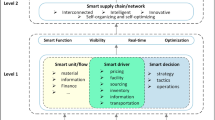Abstract
As a new management pattern, ‘cluster supply chain’ (CSC) can help small and medium enterprises (SMEs) in China to face the sharp global competitions through all kinds of collaboration. However, a major challenge in implementing CSC is the gap between the related theories and practices in the field. In order to bridge the gap, this paper presents the JingCheng Mechanical & Electrical Holding co., Ltd. (JCH) as a case study to explain the key problems in the practice of cluster supply chain: What are the specific conditions for the implementation of cluster supply chain? What are the advantages and challenges of implementing cluster supply chain? Furthermore, the role of service supporting system is emphasized, which has driven a process of transforming CSC theories into practices. Through the case study of JCH, we clarify the role of service system in the actual construction and operation of cluster supply chain, which can promote the rapid adoption of CSC and show successful results as it should be.
Similar content being viewed by others
References
Porter ME (1998) Clusters and the new economics of competition. Harv Bus Rev 76(6): 77–90
Brenner T (2005) Innovation and cooperation during the emergence of local industrial clusters: an empirical study in Germany. Eur Plan Stud 13(6): 921–938
Antoldi F (2006) Between local tradition and global competition: introduction to phenomenon of Italian industrial districts. In: Antoldi F (ed) Small enterprises and industrial districts. Il Mulino, Bologna
Biswas S, Roy S, Seshagiri S (2007) Collaboration in Indian SME clusters: a case study. In: Steinfield C et al. (eds) Proceedings of the 3rd international conference on communities and technologies. Springer, Berlin, pp 28–30
DeWitt T, Giunipero LC, Melton HL (2006) Clusters and supply chain management: the Amish experience. Int J Phys Distrib Logis Manag 36(4): 289–308
Camarinha-Matos LM, Afsarmanesh H et al (1999) Infrastructure for virtual enterprise [M]. IFIP TC5 WG5.3/PRODNET working conference on infrastructure for virtual enterprise (PRO-VE99), October 27–28, Porto, Portugal
Power D (2005) Supply chain management integration and implementation: a literature review. Supply Chain Manag Int J 10(4): 252–263
Christopher M (2005) Logistics and supply chain management: creating value-added networks. Pearson education, Harlow
Lazzarini SG, Chaddad FR, Cook ML (2001) Integrating supply chain and network analyses: the study of netchains. Chain Netw Sci 1(1): 7–22
Li J (2006) Study on cluster supply chain and its management. PHD thesis. Huazhong Agricultural University, Wuhan, China
Li J, Liu C, Li B (2007) Modeling of the across-chain inventory coordination in cluster supply chains. Syst Eng Electron 29(9): 1479–1483
Wu Q, Chen F (2007) On structure and link mode of cluster supply chain network. J Chengdu Univ Technol (Social Sciences) 15(4): 65–70
Li J, Liu C et al (2006) Integrated analysis of the organizational succession in cluster supply chain and the development to logistical park: the case study of IT industry in Suzhou. China Soft Sci 1: 108–116
Mikkola JH, Skjott-Larsen T (2004) Supply chain integration: implications for mass customization, modularization and postponement strategies. Prod Plan Control 15(4): 352–361
Patti AL (2006) Economic clusters and the supply chain: a case study. Supply Chain Manag Int J 11(3): 266–270
Fox MS, Chionglo JF, Barbuceanu M (1993) The integrated supply chain management system. Internal Report, Dept. of Industrial Engineering, University of Toronto
Villa A, Antonelli D, Cassarino I (2005) Issues in the management of collaborative demand and supply networks. In: Strengthening competitiveness through production networks. European Communities, Belgium, pp 47–57
Min Z, Feiqi D, Sai W (2008) Coordination game model of co-opetition relationship on cluster supply chains. J Syst Eng Electron 19(3): 499–506
Siau K, Tian Y (2004) Supply chains integration: architecture and enabling technologies. J Comput Inf Syst 44(3): 67–72
Hendricks KB, Singhal VR, Stratman JK (2007) The impact of enterprise systems on corporate performance: a study of ERP, SCM and CRM system implementation. J Oper Manag 25(1): 65–82
Xue X, Huang B, Xiao T (2009) The study of inter-organizational collaboration by cluster supply chain. In: Proceedings of the third IEEE international conference on automation and logistics, pp 124–129
Kim SW (2006) The effect of supply chain integration on the alignment between corporate competitive capability and supply chain operational capability. Int J Oper Prod Manag 26(10): 1084–1107
Dayasindhu N (2002) Embeddedness, knowledge transfer, industry clusters and global competitiveness: a case study of the Indian software industry. Technovation 22(9): 551–560
Das A, Narasimhan R, Talluri S (2006) Supplier integration—finding an optimal configuration. J Oper Manag 24(5): 563–582
Kumar S, Maher M (2008) Are the temptations of online reverse auctions appropriate for your business?. Supply Chain Manag Int J 13(4): 304–316
Pietro M, Biplav S (2008) Business driven SOA customization. In: Bouguettaya A, Krger I, Margaria T (eds) Proceedings of the 2008 international conference on service-oriented computing. Springer, Heidelberg, pp 286–301
McIvor R, Humphreys P, Huang G (2000) Electronic commerce: re-engineering the buyer-supplier interface. Bus Process Manag J 6(2): 122–138
Author information
Authors and Affiliations
Corresponding author
Additional information
We would express our great thanks to the anonymous reviewers for their valuable comments. This work was funded by Chinese NSF Program under grant 60905041 and 61175066, The National Science Foundation for Post-doctoral Scientists of China under Grant 20110490396, the Program for Science Technology Innovation Talents in Universities of Henan Province under Grant 2012HASTIT013, and the Young Scientist Fund in Universities of Henan Province under Grant 2011GGJS-056.
Rights and permissions
About this article
Cite this article
Xue, X., Wei, Z. & Liu, Z. The impact of service system on the implementation of cluster supply chain. SOCA 6, 215–230 (2012). https://doi.org/10.1007/s11761-012-0104-4
Received:
Revised:
Accepted:
Published:
Issue Date:
DOI: https://doi.org/10.1007/s11761-012-0104-4




